
USS Admiral W. S. Sims (AP-127) was a transport in the United States Navy. She was later renamed USNS General William O. Darby (T-AP-127). Later her name was struck and she was known simply by her hull number. In 1981, she was reclassified as IX-510.

USS Admiral W. L. Capps (AP-121), an Admiral W. S. Benson-class transport, was the second ship of the United States Navy to be named for Rear Admiral Washington L. Capps (1864–1935). Unusually, the first — USS Capps (DD-550) — served concurrently with the Admiral W. L. Capps. Via a transfer to the United States Army and then back to the Navy, the ship was renamed USNS General Hugh J. Gaffey (T-AP-121), making her the only ship to be named for Hugh Joseph Gaffey.

USS Argonne (AP-4/AS-10/AG-31) was a Design 1024 cargo ship built under United States Shipping Board contract by the International Shipbuilding Corp., Hog Island, Pennsylvania, for the United States Department of War. Named Argonne for the U.S. Army's Meuse-Argonne campaign in World War I, she was completed in 1920, delivered to the War Department in December 1920, laid up in February 1921, and loaned to the Navy on 3 November 1921. Accepted preliminarily by the Navy on that date, she was commissioned as Argonne on 8 November 1921 at the Philadelphia Navy Yard. The ship was permanently transferred to the Navy 6 August 1924 by Executive Order.

USS Neshoba was a Haskell-class attack transport in service with the United States Navy from 1944 to 1946. She was scrapped in 1975.

USS Wharton (AP-7) was a troop transport in the service of the United States Navy during World War II. The ship was originally an Emergency Fleet Corporation Design 1029 type built for the United States Shipping Board. The ship was laid down as Manmasco but renamed and launched as Sea Girt then completed September 1921 as Southern Cross. The ship was first allocated by the United States Shipping Board to the Munson Steamship Line until purchased by the line in 1925. Munson operated the Southern Cross in the South American trade from 1921 until 1938 when the ship was sold at a Marshall's sale and taken over by the United States Maritime Commission which paid the full mortgage claim.
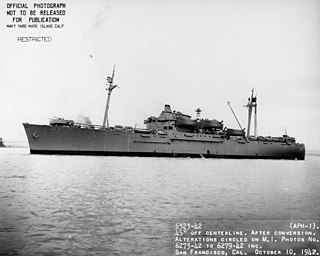
USS Tryon (APH-1) was laid down as SS Alcoa Courier on 26 March 1941, by the Moore Dry Dock Company, Oakland, California and launched on 21 October 1941 sponsored by Mrs. Roy G. Hunt. After the attack on Pearl Harbor, she was designated for U.S. Navy use and assigned the name Comfort in June 1942. Comfort was renamed Tryon on 13 August 1942, acquired by the U.S. Navy on 29 September 1942, and commissioned on 30 September 1942.

USS General O. H. Ernst (AP-133) was a General G. O. Squier-class transport ship for the U.S. Navy in World War II. She was named in honor of U.S. Army general Oswald Herbert Ernst. She was decommissioned in 1946 and transferred to the Army Transport Service as USAT General O. H. Ernst. She was sold privately in 1964 and renamed SS Calmar, and was scrapped in 1980.

USS General C. G. Morton (AP-138) was a General G. O. Squier-class transport ship for the U.S. Navy in World War II. She was named in honor of U.S. Army general Charles Gould Morton. She was transferred to the U.S. Army as USAT General C. G. Morton in 1946. On 1 March 1950 she was transferred to the Military Sea Transportation Service (MSTS) as USNS General C. G. Morton (T-AP-138). She was later sold for commercial operation under the name SS Green Wave, before being scrapped in 1980.

USS General C. H. Muir (AP-142) was a General G. O. Squier-class transport ship for the U.S. Navy in World War II. The ship was crewed by the U.S. Coast Guard until decommissioning. She was named in honor of U.S. Army general Charles Henry Muir. She was transferred to the U.S. Army as USAT General C. H. Muir in 1946. On 1 March 1950 she was transferred to the Military Sea Transportation Service (MSTS) as USNS General C. H. Muir (T-AP-142). She was later sold for commercial operation under the names SS Chicago and SS San Juan, and was scrapped some time after 1985.

USS General H. B. Freeman (AP-143) was a General G. O. Squier-class transport ship for the U.S. Navy in World War II. The ship was crewed by the U.S. Coast Guard until decommissioning. She was named in honor of U.S. Army general Henry Blanchard Freeman. She was transferred to the U.S. Army as USAT General H. B. Freeman in 1946. On 1 March 1950 she was transferred to the Military Sea Transportation Service (MSTS) as USNS General H. B. Freeman (T-AP-143). She was sold for commercial operation in 1965, and eventually scrapped.

USNS General H. H. Arnold (T-AGM-9) was a General G. O. Squier-class transport ship for the U.S. Navy in World War II. She was named in honor of U.S. Army general Robert Emmet Callan. She was transferred to the U.S. Army as USAT General R. E. Callan in 1946. On 28 April 1950 she was transferred to the Military Sea Transportation Service (MSTS) as USNS General R. E. Callan (T-AP-139). Placed in reserve in 1958, she was transferred to the U.S. Air Force in 1961 and renamed USAFS General H. H. Arnold in 1963, in honor of Henry H. Arnold, the first and only General of the Air Force. She was reacquired by the Navy in 1964 as USNS General H. H. Arnold (T-AGM-9). She was struck from the Naval Vessel Register on 1 March 1982.

USS General John Pope (AP-110) was a troop transport that served with the United States Navy in World War II. After the war she was transferred to the Army and redesignated USAT General John Pope. She later served in the Korean and Vietnam Wars as a civilian-crewed Military Sea Transportation Service vessel, as USNS General John Pope (T-AP-110).

USS General W. H. Gordon (AP-117) was a troop transport that served with the United States Navy in World War II. After the war, she was transferred to the US Army and served as USAT General W. H. Gordon. In the mid to late 1940s she sailed in trans-Pacific American President Lines passenger service with sister ship SS General Meigs. With the outbreak of the Korean War, she was reacquired by the Navy as a civilian-crewed Military Sea Transportation Service (MSTS) vessel, and redesignated USNS General W. H. Gordon (T-AP-117). She served again under the same designation in the Vietnam War.
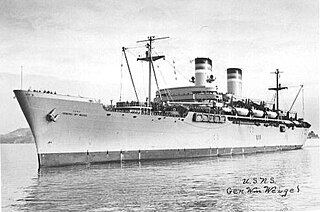
USS General William Weigel (AP-119) was a troopship that served with the United States Navy in World War II. After the war, she was acquired by the US Army and became USAT General William Weigel. On the outbreak of the Korean War, she was transferred to the Military Sea Transportation Service (MSTS) and designated USNS General William Weigel (T-AP-119), a designation she retained for her later service in the Vietnam War.
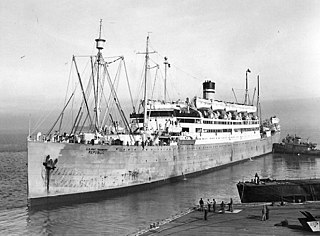
USS Republic (AP-33) was a troop transport that served with the US Navy during World War II. In World War I she served with the Navy as USS President Grant (ID-3014) before being turned over to the Army and named Republic. The ship was renamed the President Buchanan in 1921 before reverting to Republic in 1924.
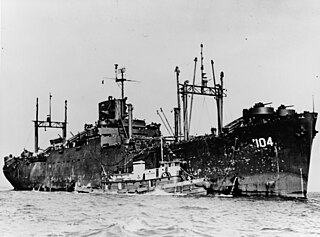
USS President Monroe (AP-104) was a President Jackson-class attack transport. that served with the US Navy during World War II. She was named after Founding Father and the fifth U.S. president, James Monroe.
USS Winged Arrow (AP-170) was a La Salle-class transport of the United States Navy. The La Salle class transport had a displacement of almost 14,000 long tons (14,000 t) and were designed to ferry troops and supplies to and from the war zone during World War II.
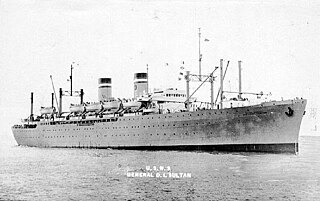
USS Admiral W. S. Benson (AP-120) began as an unnamed transport, AP-120, that was laid down on 10 December 1942 at Alameda, California by the Bethlehem-Alameda Shipbuilding Corp., under a Maritime Commission contract. She was named Admiral W. S. Benson (AP-120) on 20 October 1943 and launched on 22 November 1943; sponsored by Miss Dorothy Lucille Benson, granddaughter of the late Admiral William S. Benson. She was accepted from the Maritime Commission on 23 August 1944 and commissioned the same day.
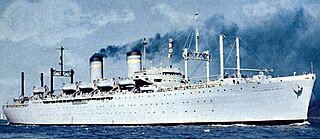
USS Admiral R. E. Coontz (AP-122) was an Admiral W. S. Benson-class transport built for the U.S. Navy during World War II. She was laid down under a Maritime Commission contract on 15 January 1943 at Alameda, California, by the Bethlehem Steel Corp., and launched on 22 April 1944. She was sponsored by Mrs. Edwin Kokko, daughter of Admiral Coontz, and commissioned on 21 November 1944.

USS Admiral E. W. Eberle (AP-123) was laid down on 15 February 1943 under a Maritime Commission contract by the Bethlehem Shipbuilding Corporation, Alameda, California; launched on 14 June 1944; sponsored by Mrs. Earl Warren, the wife of the Governor of California who later became Chief Justice of the United States Supreme Court; and acquired by the Navy and commissioned on 24 January 1945.



















